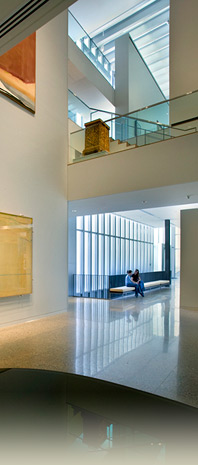Home // Exhibitions // University of Michigan Museum of Art
UM Museum of Art
- January 16 - April 11
UMMA Projects: Cory Arcangel - January 23 - April 18
Tradition Transformed: Chang Ku-nien, Master Painter of the 20th Century - January 30 - May 2
An Economy of Means: The Dorothy and Herbert Vogel Collection - March 27 - June 6
Art, Anti-Art, Non-Art: Experiments in the Public Sphere in Postwar Japan, 1950-1970
January 16 - April 11
UMMA Projects: Cory Arcangel
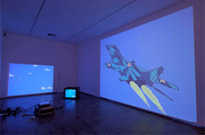
MIG 29 Soviet Fighter Plane and Clouds
2005
two handmade hacked Nintendo cartridges and games systems
multi-channel projections
dimensions variable
Courtesy of the artist and Team Gallery, New York
Cory Arcangel (b. 1977, New York) is often described as a "digital media" artist, although he is more fully understood as an artist concerned with the forms and processes of digital and media culture. Having first gained widespread recognition for his reworking of obsolete video game systems, his practice has grown to encompass imagery and sound drawn from across popular culture, ranging from Guns and Roses' iconic Sweet Child of Mine music video to Glenn Gould's landmark recording of Bach's Goldberg Variations. Arcangel, who studied classical performance and electronic music composition (under tape-music pioneer Pauline Oliveros) at the Oberlin Conservatory, approaches these familiar sources–and the technology by which they are delivered–with the unusual but effective combination of compositional rigor and pitch-perfect deadpan humor. Arcangel's work has appeared in numerous important group exhibitions and has attracted international attention in recent years. This will be Arcangel's first solo exhibition in a North American museum. His installation at UMMA is a newly commissioned work.
This project is made possible in part by the University of Michigan Office of the President and UMMA's New Visions Venture Fund including the Susan and Richard Gutow Fund.
January 23 - April 18
Tradition Transformed: Chang Ku-nien, Master Painter of the 20th Century
Guest curator: Wen-chien Chang
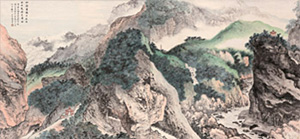

Chang, Ku-nien (1906 - 1987)
Taiwan Cross-Island Highway - section 1
1967
4 hanging scroll as a panel, ink and color on paper
152 x 82.5 cm
UMMA Gift of Cheng-yang and Shirley Chang
This exhibition features the work of Chang Ku-nien (1906-1987), a versatile and proficient artist from the last generation of an ancient tradition of Chinese painting, and explores his development as an artist over a lifetime.
Trained in Shanghai, the versatile Chang resettled in Taiwan after the political upheaval of 1949. This experience compelled him to carry on the tradition of Chinese painting, which was considerably diminished in China during the Culture Revolution. A member of the fabled Seven Friends Painting Society in Taiwan, Chang responded dynamically to the vitality of his new environment and second homeland, where he freely experimented with new techniques to portray local nature and landscape themes. In his later years, he traveled between Taiwan and the United States and created a highly expressive, personal, and sensitive vision of the landscapes of North America.
Many of the paintings presented here are gifts to the Museum of Art from Dr. Cheng-Yang Chang, Chang Ku-nien's son, and include monumentally scaled works that can be presented only rarely due to their fragility and size. The exhibition is accompanied by the first publication to be produced by an American museum about the artist's life and work.
This exhibition is made possible in part the E. Rhodes and Leona B. Carpenter Foundation, the University of Michigan Office of the Provost, and the Blakemore Foundation. Additional support was provided by Mary Palmer and the George Dewey and Mary J. Krumrine Endowment.
January 30 - May 2
An Economy of Means: The Dorothy and Herbert Vogel Collection
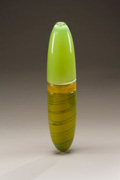
Lynda Benglis
American, born 1941
Tacpere Maptom
1985
glass
22 x 5.5 (diam.) in.
©Lynda Benglis / Licensed by VAGA, New York, NY
Project curator: Jacob Proctor
The Dorothy and Herbert Vogel Collection is notable both for the character and breadth of the objects and for the individuals who created it. Herbert Vogel (b. 1922) spent most of his working life as an employee of the United States Postal Service, and Dorothy Vogel (b. 1935) was a reference librarian at the Brooklyn Public Library. Setting their collecting priorities above those of personal comfort, the couple used Dorothy's salary to cover the expenses of daily life and devoted Herbert's salary to the acquisition of contemporary art. The couple began collecting in the early 1960s, with a focus on minimal and conceptual art, though they also embraced a wide range of post-minimal practices as well as new figurative directions that emerged in the 1980s. As the first collectors to buy work by many artists who were then unknown to a wide audience, the Vogels offered encouragement at the start of the careers of several figures-artists like Robert Barry, Edda Renouf, and Richard Tuttle, among many others-who went on to achieve considerable acclaim. Many works in the collection were given to the Vogels as gifts, a testament to the Vogels' close and longstanding relationships with many of the artists they supported. The exhibition is drawn from the Vogels' recent gift of fifty works to the Museum of Art, donated as part of The Dorothy and Herbert Vogel Collection: Fifty Works for Fifty States, a national initiative to place fifty works from the collection in a selected art institution in each of the fifty states.
This exhibition is made possible in part by the Friends of the University of Michigan Museum of Art.
March 27 - June 6, 2010
Art, Anti-Art, Non-Art: Experiments in the Public Sphere in Postwar Japan, 1950-1970
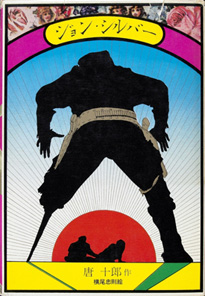
Yokoo Tadanori (b.1936) (Book jacket design)
Kara Juro, Jon Shiruba (John Silver) (Tokyo, 1969)
Photomechanical print
Research Library, The Getty Research Institute, Los Angeles, California (2623-309)
© Yokoo Tadanori
Art, Anti-Art, Non-Art highlights a dynamic phase of avant-garde art in postwar Japan characterized by self-reflection and multimedia experimentation. From 1950 to 1970, numerous artistic groups emerged, notably Gutai Art Association, Group Ongaku, Fluxus/Tokyo Fluxus, Neo Dada, Hi Red Center, Vivo, Provoke, Intermedia, and Experiments in Art and Technology (E.A.T).
Artists associated with these innovative groups tested the definition and practice of art by producing objects and ephemera that combined a variety of traditional and new media, including sound improvisation, language, performance, photography, video, and an expanded notion of sculpture. The artists collaborated beyond the boundaries of collectives, artistic genres, and conventional exhibition spaces, often presenting their work in the streets, temporary theaters and other public spheres. In addition, the Tokyo Olympics in 1964 and the Japan World Exposition in 1970 contributed to the emergence of Japan as a center of international contemporary culture and the arts.
This exhibition has been organized by the Getty Research Institute, Los Angeles. The exhibition and related programs are made possible in part by the University of Michigan Center for Japanese Studies and the Department of the History of Art.
For information on these and other exhibitions and events visit: http://www.umma.umich.edu/view/
